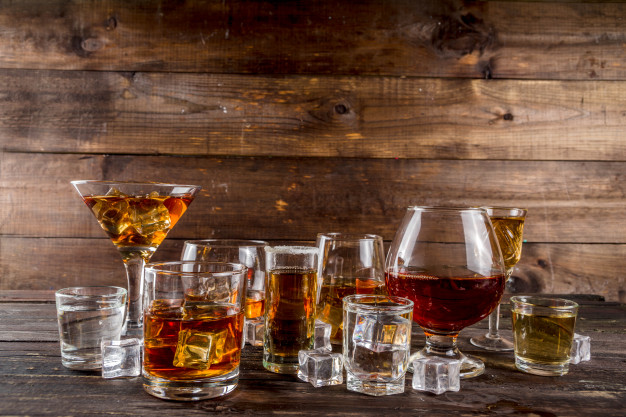The main difference between alcohols and phenols is that alcohols are organic compounds containing the -OH group as an essential component while phenol is a group of alcohols with the -OH group and a benzene reaction as the essential components.
Organic chemistry has aliphatic and aromatic compounds, which share similar functional groups. However, their properties may differ from each other due to their aromatic or balsamic nature. Alcohols are organic compounds with -OH groups as functional groups. Phenol is a class of alcohol. In particular, it has an -OH group attached to an aromatic ring. Therefore, unlike most other alcohol compounds, it has somewhat different properties.
What is alcohol?

The factor of the alcohol family is the presence of a -OH functional group (hydroxyl group). Generally, this -OH group binds to sp 3 hybridized carbons. The ordinary member of this family is methyl alcohol, which we name methanol. We can categorize alcohol into three groups as primary, secondary, and tertiary. Here, this classification depends on the degree of substitution of carbon by which the hydroxyl group is added directly.
There, if only one other carbon is added to the carbon, we name it as the primary carbon and the alcohol is a primary alcohol. Similarly, if a carbon with a hydroxyl group connects to two other carbons, it is a secondary alcohol, and so on. We name the wine with a suffix -ol IUPAC according to nomenclature. First, we need to select the longest continuous carbon chain to which the hydroxyl group is directly attached. Then we have to rename the corresponding alkane except for the last letter and add the suffix ol.
Also, alcohols have higher boiling points than hydrocarbons or feathers. The reason for this is the presence of intermolecular contact between these molecules through the bonding of hydrogen. If the R group is small, the alcohol is lost with water. But as the R group grows larger, it becomes hydrophobic. Furthermore, these molecules are polar. There, C – O bonds and O – H bonds contribute to the polarity of the molecule. The polarization of the O – H bond makes hydrogen partially positive and explains the acidity of the alcohol.
Classification of Alcohols:
These can be further classified as follows –
Based on carbon atom direct link of an -OH group containing carbon atom.
Based on the number of -OH groups
Allyl alcohol
Benzyl alcohol
Vinyl alcohol
The -I effect of the -Cl group in this increases the same stability.
Due to the formation of endogenous hydrogen bonds in chloral hydrate.
Based on a carbon atom which direct link of -OH group containing carbon atom (based on the number of other carbons attached to carbon-containing -OH group):
Primary alcohols: In this, the carbon-containing -OH group is associated with other carbon.
Secondary alcohols: The carbon-containing the –OH group is joined with the other two carbons.
Secondary alcohols: The carbon-containing -OH group is joined with the other three carbons.
Based on the number of -OH group (based on several -OH group):
They are further divided as follows –
Mono-Hydraulic Alcohol: They consist of exactly one -OH group.
Example: CH3-OH methyl alcohol
CH3-CH2-OH Ethyl Alcohol
Die-Hydric Alcohols: They consist of two -OH groups.
Example: Ethane-1-2doll
Tri-Hydraulic Alcohol: They contain three -OH groups.
Example: Glycerin
Poly-hydric alcohols: They contain more than three -OH groups.
Examples: Hexane 1, 2,3,4,5,6, and Hexol ol
Allyl alcohol: These can be further classified as follows –
Primary alcohols Allyl: Example – Allyl alcohols or Prop-2N-1-ol
Secondary allyl alcohol: Example: buty-3-en-2-ol
Tertiary allyl alcohol: Example – 2-methyl-buty 3-en-ol
Benzyl alcohol: It is further divided as follows –
Primary benzyl alcohol:
Examples – benzyl alcohol or 1-phenyl methanol
Secondary benzyl alcohol:
Example – 1-Phenyl alcohol
Tertiary Benzyl Alcohol:
Example: 2-phenyl 2 – propanol
Phenyl prop-2-ol
Vinyl alcohol:
OH group containing carbon is SP2 hybridized.
Example: vinyl alcohol
What are Phenols?

Phenol is a derivative of aromatic hydrocarbons and benzene. Phenol is a kind of white crystalline substance with the molecular formula C 6 H 6 OH. It is flammable and has a strong odor. The molecular weight is approximately 94 g mol – 1. The melting point is 40.5 oC, and the boiling point is 181 o C. Also, the density is 1.07 g cm -3.
Therefore, in the process of formation, the hydrogen atom in the benzene molecule substitutes with a -OH group to give phenol. Therefore, it has an aromatic ring structure similar to that of benzene. But its properties differ due to the –OH group. Phenol is mildly acidic (acidic compared to alcohol). Also, it is moderately soluble in water, as it can form hydrogen bonds with water. However, phenol evaporates slower than water.
What is the difference between alcohol and phenol?
| Alcohol | Phenol |
| Alcohols are organic compounds in which the -OH group is called a functional group. | Phenol is a derivative of aromatic hydrocarbons and benzene. It is also a type of alcohol. |
| alcohols are organic compounds with the -OH group as an essential component | Phenols are a group of alcohols with a -OH group and a benzene ring as the essential components. |
| -OH alcohol binds to an SP 3 carbon hybridized to phenol | It binds to a sp 2 hybridized carbon. |
| Alcohols are weaker than phenols. | Phenols are much stronger acids than alcohols. |
| Generally, aliphatic hydrocarbons. | Aromatic hydrocarbons |
| Aliphatic alcohols are less acidic. | Phenols are more acidic. |





